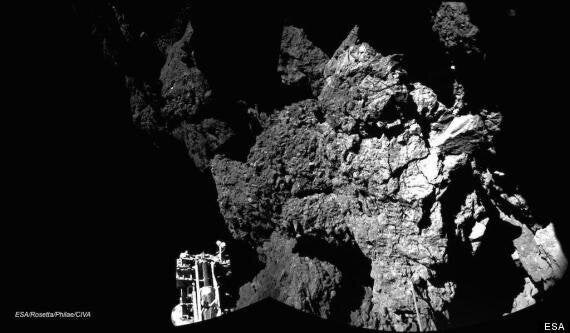Humanity has landed on a comet - and now we have the picture to prove it.
This is the first photograph taken on a comet in history.
But there is bad news too: the European Space Agency said that its Philae lander, launched from the Rosetta mothership on Wednesday, is not attached to the comet's surface. None of the systems designed to lock it in place - harpoons, ice screws or thrusters - worked.
As such the long-term viability of the lander is in doubt.
ESA said the lander is sloping - maybe on its side - but that they have 7 images and a panorama which will be published at a 1pm press conference.

Above: ESA said: "Rosetta’s lander Philae is safely on the surface of Comet 67P/Churyumov-Gerasimenko, as these first two CIVA images confirm. One of the lander’s three feet can be seen in the foreground. The image is a two-image mosaic. The full panoramic from CIVA will be delivered in this afternoon’s press briefing at 13:00 GMT"
Scientists are also concerned about the amount of shadow in the picture:
The lander was described as "stable" by Rosetta project scientist Dr Matt Taylor, who said the European Space Agency was receiving a good signal and receiving science data.
He said: "Now we are busy analysing what it all means and really trying to find out where the lander actually is on the surface."
Philae touched down yesterday after a 10-year, four billion-mile journey through space in an achievement hailed as one of the greatest in science.
Scientists hope the probe will yield insights into the origins of our Solar System.
Philae landed in a soft area on the 67P/Churyumov-Gerasimenko comet and dipped around 1.6in (4cm) before bouncing back up when its harpoon failed to fire.
It went straight back up for two hours and drifted out into space before descending to the surface, bouncing again for a few minutes before settling in what Dr Taylor described as "three landings for the price of one".
"The descent was due on to a particular point on the surface of the comet; the bounce would have made it go up and then the comet's rotating underneath," the British scientist said.
"So we know, if we are looking at an image, that most likely the lander is somewhere on the right and now we are trying to refine that to really start focusing on the orbiter images to see where it is.
"In the next few hours we hope to be piecing the data we get on the lander to add this all together."
The picture follows the release late on Wednesday of pictures from just above the surface:
This may be the first picture ever taken from the surface of a comet. #CometLanding (via @serpientes72) pic.twitter.com/C23KGWHrAG
— Garrett Frankson (@Garrettishere) November 12, 2014
Dr Taylor added: "We know it's stable and sitting in place - that's about as stable as we could wish for at the moment - and the next few hours should give us a bit more illumination on what the situation is there."
Discussions are taking place on whether the probe's two harpoons should be fired now to make sure the craft is fastened down in the comet's ultra-low gravity.
ESA experts are also looking into the implications of deploying a drill which can bore out samples to a depth of 9in (23cm).
It is hoped that in the next few hours new pictures from the surface of the comet may become available.
The probe is equipped with several cameras and a suite of 10 instruments.
One British-led instrument, Ptolemy, is expected to be used to analyse the composition of samples in the craft's on-board laboratory.
Here are some of the key numbers involved in the project:
- Rosetta mission cost: Close to 1.4 billion euros (£1.1 billion), including Philae's cost of 220 million euros (£173 million)
- Philae distance from home: 316 million miles
- Mission length so far: 10 years
- Time taken for news to reach Earth: 28 minutes, 20 seconds
- Philae weight: 100 kilograms
- Comet 67P weight: 10 billion tonnes
- Number of names suggested for landing site: 8,000 (the name chosen was Agilkia)
- Length of lander's stay on comet: No one knows yet
- Number of countries behind the comet landing: 14
- Announcement retweets: 28,000 in first hour